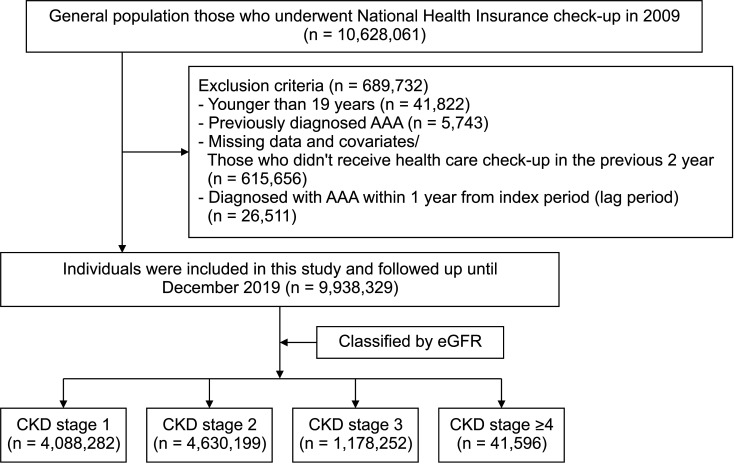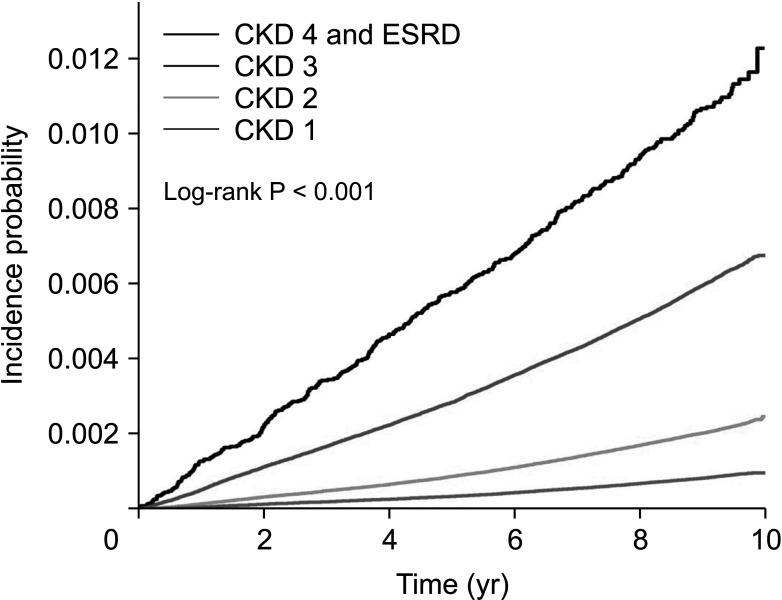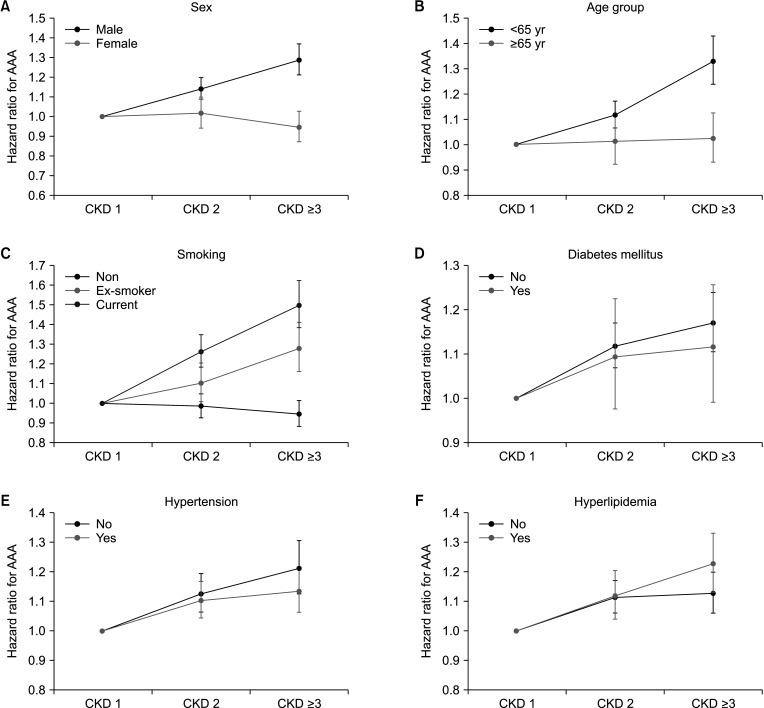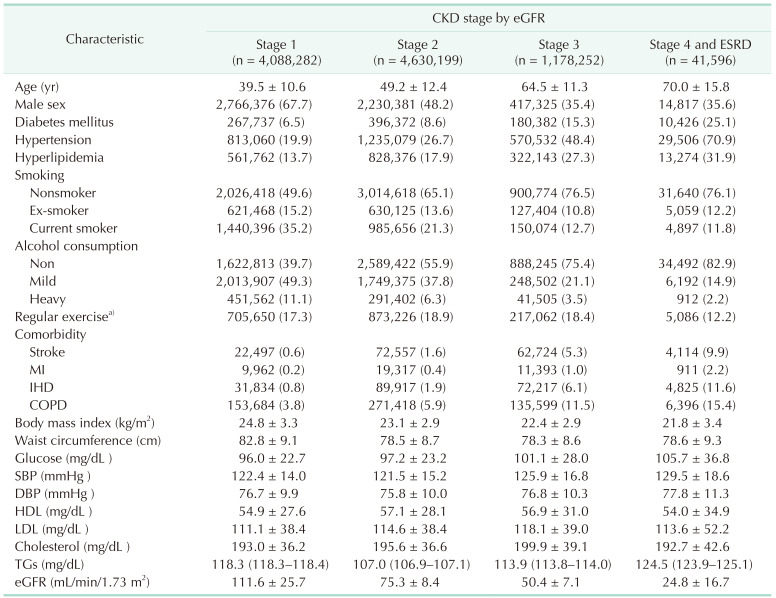1. Levey AS, Coresh J, Balk E, Kausz AT, Levin A, Steffes MW, et al. National Kidney Foundation practice guidelines for chronic kidney disease: evaluation, classification, and stratification. Ann Intern Med. 2003; 139:137–147. PMID:
12859163.

2. Chadban SJ, Briganti EM, Kerr PG, Dunstan DW, Welborn TA, Zimmet PZ, et al. Prevalence of kidney damage in Australian adults: the AusDiab kidney study. J Am Soc Nephrol. 2003; 14(7 Suppl 2):S131–S138. PMID:
12819318.

3. Stevens LA, Coresh J, Feldman HI, Greene T, Lash JP, Nelson RG, et al. Evaluation of the modification of diet in renal disease study equation in a large diverse population. J Am Soc Nephrol. 2007; 18:2749–2757. PMID:
17855641.

4. Sakalihasan N, Limet R, Defawe OD. Abdominal aortic aneurysm. Lancet. 2005; 365:1577–1589. PMID:
15866312.

5. Choi C, Ahn S, Min SI, Ahn M, Ha J, Yoon HJ, et al. Nationwide epidemiologic study of abdominal aortic aneurysms in Korea: a cross-sectional study using National Health Insurance Review and Assessment Service data. Vasc Specialist Int. 2019; 35:193–201. PMID:
31915663.

6. Matsushita K, Coresh J, Sang Y, Chalmers J, Fox C, Guallar E, et al. Estimated glomerular filtration rate and albuminuria for prediction of cardiovascular outcomes: a collaborative meta-analysis of individual participant data. Lancet Diabetes Endocrinol. 2015; 3:514–525. PMID:
26028594.

7. Svensjö S, Björck M, Gürtelschmid M, Djavani Gidlund K, Hellberg A, Wanhainen A. Low prevalence of abdominal aortic aneurysm among 65-year-old Swedish men indicates a change in the epidemiology of the disease. Circulation. 2011; 124:1118–1123. PMID:
21844079.

8. Takeuchi H, Okuyama M, Uchida HA, Kakio Y, Umebayashi R, Okuyama Y, et al. Chronic kidney disease is positively and diabetes mellitus is negatively associated with abdominal aortic aneurysm. PLoS One. 2016; 11:e0164015. PMID:
27764090.

9. Song SO, Jung CH, Song YD, Park CY, Kwon HS, Cha BS, et al. Background and data configuration process of a nationwide population-based study using the korean national health insurance system. Diabetes Metab J. 2014; 38:395–403. PMID:
25349827.

10. Kim MH, Yoo JH, Cho HJ, Ko KJ, Jun KW, Han KD, et al. Increased depression risk in patients with abdominal aortic aneurysm: a nationwide cohort study. Ann Surg Treat Res. 2021; 101:291–298. PMID:
34796145.

11. Cho HJ, Yoo JH, Kim MH, Ko KJ, Jun KW, Han KD, et al. The risk of dementia in adults with abdominal aortic aneurysm. Sci Rep. 2022; 12:1228. PMID:
35075181.

12. Hui X, Matsushita K, Sang Y, Ballew SH, Fülöp T, Coresh J. CKD and cardiovascular disease in the Atherosclerosis Risk in Communities (ARIC) study: interactions with age, sex, and race. Am J Kidney Dis. 2013; 62:691–702. PMID:
23769137.

13. Gansevoort RT, Correa-Rotter R, Hemmelgarn BR, Jafar TH, Heerspink HJ, Mann JF, et al. Chronic kidney disease and cardiovascular risk: epidemiology, mechanisms, and prevention. Lancet. 2013; 382:339–352. PMID:
23727170.

14. Hallan S, Astor B, Romundstad S, Aasarød K, Kvenild K, Coresh J. Association of kidney function and albuminuria with cardiovascular mortality in older vs younger individuals: the HUNT II Study. Arch Intern Med. 2007; 167:2490–2496. PMID:
18071172.

15. Prinssen M, Verhoeven EL, Buth J, Cuypers PW, van Sambeek MR, Balm R, et al. A randomized trial comparing conventional and endovascular repair of abdominal aortic aneurysms. N Engl J Med. 2004; 351:1607–1618. PMID:
15483279.

16. Greenhalgh RM, Brown LC, Kwong GP, Powell JT, Thompson SG. EVAR trial participants. Comparison of endovascular aneurysm repair with open repair in patients with abdominal aortic aneurysm (EVAR trial 1), 30-day operative mortality results: randomised controlled trial. Lancet. 2004; 364:843–848. PMID:
15351191.

17. Parmer SS, Fairman RM, Karmacharya J, Carpenter JP, Velazquez OC, Woo EY. A comparison of renal function between open and endovascular aneurysm repair in patients with baseline chronic renal insufficiency. J Vasc Surg. 2006; 44:706–711. PMID:
16930930.

18. Prytherch DR, Sutton GL, Boyle JR. Por tsmouth POSSUM model s for abdominal aortic aneurysm surgery. Br J Surg. 2001; 88:958–963. PMID:
11442527.
19. Lee TH, Marcantonio ER, Mangione CM, Thomas EJ, Polanczyk CA, Cook EF, et al. Derivation and prospective validation of a simple index for prediction of cardiac risk of major noncardiac surgery. Circulation. 1999; 100:1043–1049. PMID:
10477528.

20. Biancari F, Hobo R, Juvonen T. Glasgow Aneurysm Score predicts survival after endovascular stenting of abdominal aortic aneurysm in patients from the EUROSTAR registry. Br J Surg. 2006; 93:191–194. PMID:
16392108.

21. Chun KC, Teng KY, Chavez LA, Van Spyk EN, Samadzadeh KM, Carson JG, et al. Risk factors associated with the diagnosis of abdominal aortic aneurysm in patients screened at a regional Veterans Affairs health care system. Ann Vasc Surg. 2014; 28:87–92. PMID:
24189004.

22. Matsushita K, Kwak L, Ballew SH, Grams ME, Selvin E, Folsom AR, et al. Chronic kidney disease measures and the risk of abdominal aortic aneurysm. Atherosclerosis. 2018; 279:107–113. PMID:
30290962.

23. Otaki Y, Watanabe T, Konta T, Watanabe M, Asahi K, Yamagata K, et al. Impact of chronic kidney disease on aortic disease-related mortality: a four-year community-based cohort study. Intern Med. 2021; 60:689–697. PMID:
33642559.

24. Andreucci M, Provenzano M, Faga T, Michael A, Patella G, Mastroroberto P, et al. Aortic aneurysms, chronic kidney disease and metalloproteinases. Biomolecules. 2021; 11:194. PMID:
33573220.

25. McMillan WD, Tamarina NA, Cipollone M, Johnson DA, Parker MA, Pearce WH. Size matters: the relationship between MMP-9 expression and aortic diameter. Circulation. 1997; 96:2228–2232. PMID:
9337194.
26. Cheng S, Pollock AS, Mahimkar R, Olson JL, Lovett DH. Matrix metalloproteinase 2 and basement membrane integrity: a unifying mechanism for progressive renal injury. FASEB J. 2006; 20:1898–1900. PMID:
16891619.

27. Nakano T, Ninomiya T, Sumiyoshi S, Fujii H, Doi Y, Hirakata H, et al. Association of kidney function with coronary atherosclerosis and calcification in autopsy samples from Japanese elders: the Hisayama study. Am J Kidney Dis. 2010; 55:21–30. PMID:
19765871.

28. Pelisek J, Assadian A, Sarkar O, Eckstein HH, Frank H. Carotid plaque composition in chronic kidney disease: a retrospective analysis of patients undergoing carotid endarterectomy. Eur J Vasc Endovasc Surg. 2010; 39:11–16. PMID:
19906548.

29. Reeps C, Maier A, Pelisek J, Härtl F, Grabher-Meier V, Wall WA, et al. Measuring and modeling patient-specific distributions of material properties in abdominal aortic aneurysm wall. Biomech Model Mechanobiol. 2013; 12:717–733. PMID:
22955570.

30. Raghavan ML, Hanaoka MM, Kratzberg JA, de Lourdes Higuchi M, da Silva ES. Biomechanical failure properties and microstructural content of ruptured and unruptured abdominal aortic aneurysms. J Biomech. 2011; 44:2501–2507. PMID:
21763659.










 PDF
PDF Citation
Citation Print
Print



 XML Download
XML Download